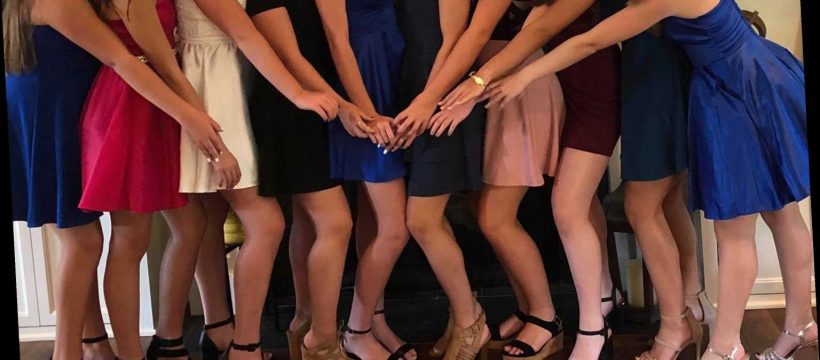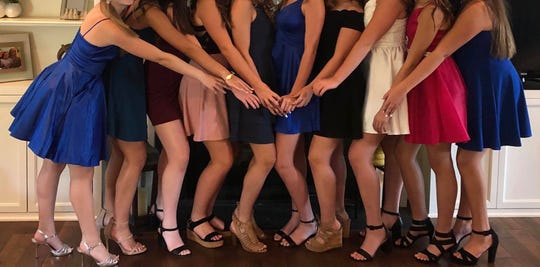LOUISVILLE, Ky. – Carrie Vittitoe just needed to buy a homecoming dress for her daughter.
Finding a knee-length dress for her 5-foot-8 daughter to appease the dress code at Louisville’s Eastern High School was a tall order.
They bounced through at least five stores, finding only one dress that met the length requirement. It was in the misses section, not the juniors section, and Vittitoe would have to pay extra to have it altered to fit her daughter, then a freshman.
They ultimately settled on a pair of culottes – essentially a jumpsuit that hits midcalf and flows similarly to a dress. But then Vittitoe worried her daughter would break the dance dress code for not wearing a dress.
“This is ridiculous,” Vittitoe remembers thinking.
A year later, Vittitoe’s daughter and several of her classmates weren’t allowed inside their homecoming dance. Their dresses, judged by Eastern administrators measuring hem lines with rulers, were too short.
‘Sexism issue’: Parents decry dress code after daughters denied entry to school dance
The homecoming woes are indicative of a larger issue at Eastern and other schools: a dress code that stringently polices girls’, but not boys’, clothing.
And girls miss classes and dances, and receive suspensions, over what they wear.
Now, weeks after homecoming, Eastern may significantly relax both its daily and event dress codes.
Girls may be able to wear shorts, skirts and dresses that hit “mid-thigh” under a proposal in front of the school’s site-based decision-making council. They would also be allowed to wear leggings, district spokeswoman Renee Murphy said.
The “mid-thigh” requirement would extend to events like homecoming, reducing a 2-inch above-the-knee rule that caused late September’s controversy.
The recommendations are “more realistic” for students and parents, Vittitoe said.
A school’s site-based decision-making council, which includes parents, teachers and an administrator, selects dress codes in Jefferson County Public Schools. Those codes range from nonexistent to providing specific sleeve and pant lengths to a clear uniform.
If passed by Eastern’s council, the proposed changes could lower the number of Eastern students – particularly females – getting into trouble and missing class for what they wear.
Students attending a dance at Eastern High School in Louisville were told their dresses must be no more than 2 inches above the knee. Some were turned away, a parent says. (Photo: Photo provided)
Eastern reported 670 individual dress code violations from August 2018 to mid-October 2019 – the second-highest figure in the district.
Only five other JCPS schools reported more than 150 dress code issues.
Boys receive slightly more dress code citations than girls in JCPS – about 52% of roughly 3,700 incidents. But in schools without uniforms, where dress codes can be applied more subjectively, girls make up the majority of infractions – almost 60%.
More than half of Eastern’s hundreds of dress code violations, for example, went to its female students. And black students received 52% of the citations, despite making up less than a quarter of Eastern’s student body.
Members of the district’s school climate team review every behavior incident, looking for trends, Murphy said. JCPS is working to decrease racial disproportionalities in discipline, including on the dress code front.
Students helped draft rules: Virginia school district adopts dress code that isn’t sexist
If a student runs afoul of the dress code, schools typically talk with the student or call their parents. Getting pulled out of class to talk with a principal or wait for someone to drop off new clothes can cause a student to miss instruction.
Students may also get a detention or in-school suspensions for repeat issues.
Since August 2018, more than 700 incidents landed kids in in-school suspension over what they wore to school. More than 1,000 violations ended with a detention.
Under JCPS’ behavior handbook, schools are not supposed to suspend students out of school over dress code violations.
Thirteen students, however, missed at least a day of class because of what they wore between August 2018 to October.
Murphy said schools can progress past the ascribed discipline in the handbook after several attempts to have a different resolution.
Many of the behavior reports of the suspensions note students had had dress code issues in the past. Some students had been warned the day before, administrators wrote, only to show up the next day and do the same thing.
School dress codes often include more stringent requirements for girls.
Of the recommended changes to Eastern’s dress code, only one – reducing how formal a boy’s’ event attire needs to be – impacts males. It doesn’t impact boys’ day-to-day clothing decisions.
On top of getting in trouble the most at schools without uniforms, girls also make up nearly 60% of tougher punishments such as in- and out-of-school suspensions.
“I don’t understand why they are policing girls so heavily,” Vittitoe said.
It’s a “sexism issue,” Vittitoe and others have previously said.
Some teachers “live and die by the dress code,” she said. Educators fear how students will react or how much they’ll push boundaries if the dress code is relaxed, she said.
But she would rather classrooms focus on learning and respect, not how long someone’s shorts are.
“Fear is not always the best reason to not make progress.”
Follow Olivia Krauth on Twitter: @oliviakrauth.
Source: Read Full Article

